CoreChair Active Ergonomic Chair Review
- Lab tested
Like most reviews sites, our editorial staff and laboratory testing expenses are partially offset by earning small commissions (at no cost to you) when you purchase something through those links. Learn More

Overview
| Review Summary |
“Active Sitting” is yet another means of fighting the sedentary lifestyle. A healthy work routine involves moving during the day—alternating between sitting, standing, and of course, walking. The CoreChair promises to make your sitting time less sedentary. How well does it perform? Our team of testers tried it out over the last several weeks. Here’s our verdict below. |
|---|---|
| MSRP / List Price | $795 |
| Street Price | Scan for available discount deals |
| Shipping |
5-7 BUSINESS DAYS |
| Warranty |
12 Year |
| Sizes Available |
Standard—for individuals up to 5’6″ |
| Colors Available |
Knit Cushion Style: Black on Green |
| Adjustment Range |
Standard: 17.1″-19.2″ |
| Dimensions |
Seat Width 19.3″ |
| Where to buy |
Buy on Amazon |
Rating
| Expert Rating | |
|---|---|
| Stability | |
| Customer Experience | |
| Quality and Aesthetics | |
| Ergonomics | |
| Innovation | |
| Value | |
| Positives | Promotes significant core muscle engagement, 14-degree angling allows stretching lower back and hips, increases blood flow through legs, simple and elegant design, all components made from recycled materials |
| Negatives | Price (though comparable to chairs in its class), a bit of a learning curve, depth adjustment makes slight spring noise, tension adjustment may require a bit of force to move |
Bottom Line
Review
CoreChair Ergonomic Chair: A Balancing Act
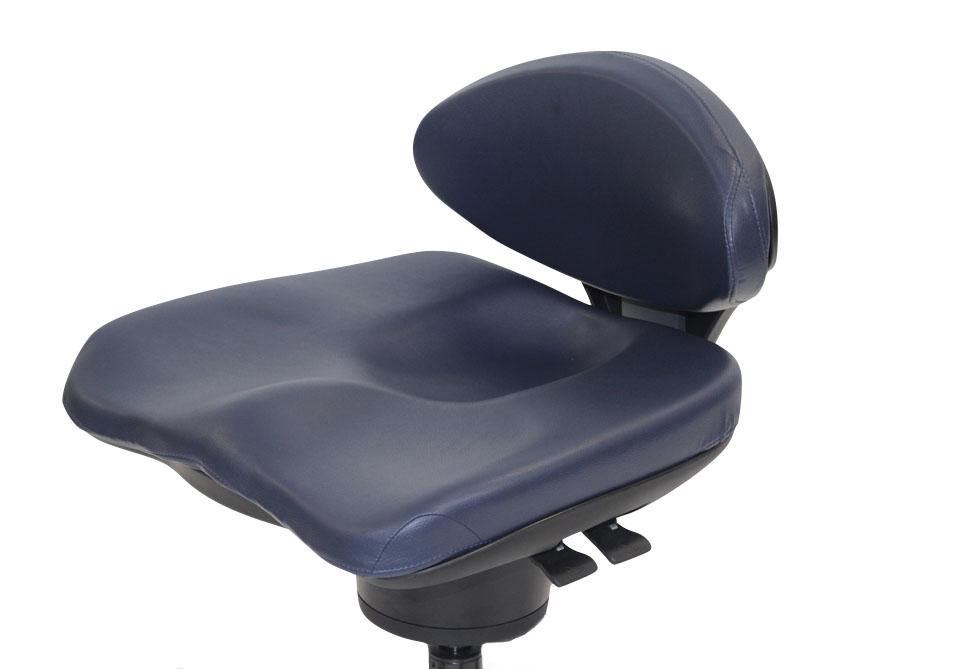
At WorkWhileWalking we’re all about incorporating more movement into your daily work routine—movement that is as healthy and as ergonomically-sound as possible. Why did the CoreChair spark our interest? Well, for one, it is an officially NEAT-certified product, having received the prestigious stamp-of-approval from the Mayo Clinic-sponsored organization led by Dr. James Levine. Second, we’ve reviewed many competing ergonomic chair products over the last several years, and would be loath to miss this chance to test a product like the CoreChair, whose promising and innovative design we thought might just disrupt the active sitting world.
Inspired by Exercise Balls in the Office
First of all, let’s give some backstory on the CoreChair. Exercise balls have long been an option for office workers looking to avoid the perils of sitting all day—of which core muscle atrophy is one. Exercise balls stimulate your core muscles as your body works to remain upright on their round surfaces. It’s a balancing act, and one that never lets up. In short spurts—no problems—but over the course of a long work day, retaining your balance brings on fatigue. With fatigue comes overcompensating for worn-out muscles, and that means hunching and leaning in ways that are unhealthy. The irony is you’ll end up with worse posture than you would have in a normal office chair.
So while exercise balls worked fine over short stretches, they failed to be a viable solution for lengthy days in the office—at least unless you enjoy constantly switching out your exercise ball for your real chair. Most people find that irritating—not to mention problematic given space constraints.
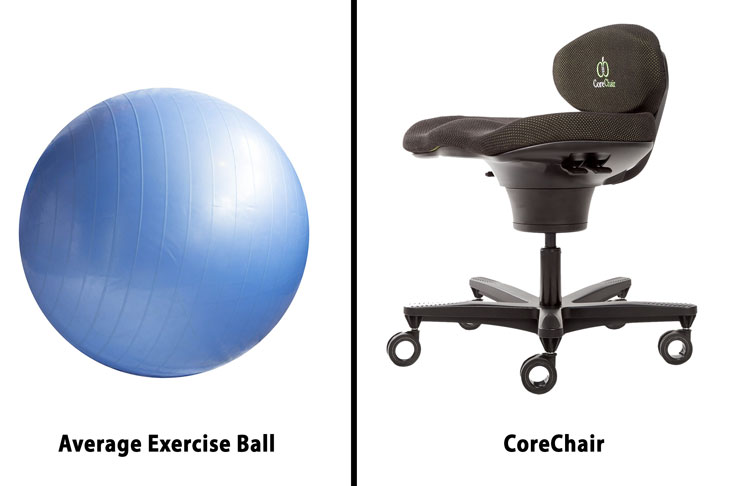
Enter the CoreChair. Like an evolved version of the office chair designed to incorporate the best-of-both-worlds between exercise balls and chairs, the CoreChair’s seat tilts to 14-degrees all the way around, so you can lean your hips in any direction you like. The act of balancing itself activates the core muscles subtly enough to keep focus while working, and if you want a break, a quick adjustment of the tension level returns the chair to more-or-less zero tilt, like a normal office seat. Wheels allow for easy mobility and the seat itself features a proven design to increase blood flow through your legs and the rest of your body.
7 Years of Product Development, Including Scientific Lab Testing
How did the CoreChair come to be? Entrepreneur Patrick Harrison, who has a degree in Kinesiology, and his team, developed the CoreChair from the ground up over the last 7 years. Throughout product development, the CoreChair underwent extensive testing, both from a scientific standpoint measuring its health benefits, and from a mechanical standpoint, including fatigue-testing up to 1 million extreme capacity cycles. In the end, the CoreChair earned a solid 12-year warranty, NEAT certification, and boasts health claims that range from stimulated blood flow, joint lubrication, increased metabolism, improved digestion, and better breathing.
While this review won’t pretend to assess these health claims in detail, after using the chair for several weeks ourselves, we’re convinced that—as counterintuitive as it sounds—your chair can now become a serious weapon against sitting disease.
CoreChair Ergonomic Chair Features Evaluated
It’s not the only ‘active sitting’ device on the market, and it’s certainly not the cheapest. (Keep in mind though that the CoreChair is almost equivalently priced feature-for-feature with the Back App 2.0, once you add the Back App wheels). It’s not uncommon to see normal office chairs range north of $500.
14-Degree Tilt in All Directions
The CoreChair is a ‘multi-axial’ chair that tilts on a pivot point right below the seat. This permits you to lean (up to 14-degrees) in every direction around the chair. A tension lever on the right side adjusts to control the difficulty level. Pushing the lever to the back offers the most resistance and pushing the lever forward offers the least resistance.
Our Team’s Tilting Notes
- Lowest tension setting offers a legitimate core workout—mild yet steady throughout the day. After a couple weeks using the lowest tension setting, we felt a noticeable difference in our core regions (including strengthened abdomen muscles). This is apparently corroborated by a study done by the Department of Kinesiology and the University of Waterloo.
- At the lowest tension setting, your first tendency may be to lurch forward, tilting the CoreChair towards your desk. Avoid this by making sure your feet rest flat on the ground (may require adjusting seat height), and sitting back in your chair.
- Be careful leaning all the way back in the lower tension settings. The tilting stops at 14-degrees but you may be surprised how fast you fall to one side or the other. Safety first. Although it does make for a nice back stretch.
- Similarly, gather yourself before you get out of the chair. You don’t have as much leverage standing up as you would in a normal chair.
- You may find yourself tired after using the CoreChair in its lowest tension for a prolonged period. You may try to lean on your desk, crisscross your legs, or tilt all the way forwards to lock in the CoreChair and avoid using your core muscles to stabilize. Resist this temptation and adjust the tension level higher instead.
- The CoreChair is different from the BackApp 2.0 in that it engages your core to remain sitting upright in the chair. The focus is on retaining stability. The Back App’s pivot point is on the ground, while the CoreChair’s pivot point is right under the seat. The CoreChair involves more hip motion while the BackApp moves your body over a larger total radius. The CoreChair seems to be a more direct descendent of the office chair whereas the BackApp seems to be more closely related to a leaning stool (in fact, without its wheels it qualifies as a stool).
Overall, we were impressed with the CoreChair’s tilting feature. No chair we’ve tried has offered this level of core muscle engagement, especially not with this range of difficulty. It can be a mild workout for your abs during the day—then, when you’re tired, it can transform back to zero tilt, and give you a little break. The tilting motion is fluid across all tension levels. And, while the tension lever can require some force to move, it’s located conveniently under the right side of the seat for easy access.
Short Back with Depth Adjustment
Where’d the back of the chair go? Good riddance, we say. Tall chair backs are bulky and frankly, unnecessary. Yes, it gives the CoreChair a bit of a ‘squatty’ look, but there’s no reason to haul around excess weight when you don’t have to; in this case, less is more.
The CoreChair calls their back support a ‘pelvic stabilizer’. It adjusts by pressing down the lever on the back left of the chair. The spring mechanism engages and the ‘pelvic stabilizer’ moves forward, tucking you right in, and providing impressive lower back support even while you tilt back-and-forth.
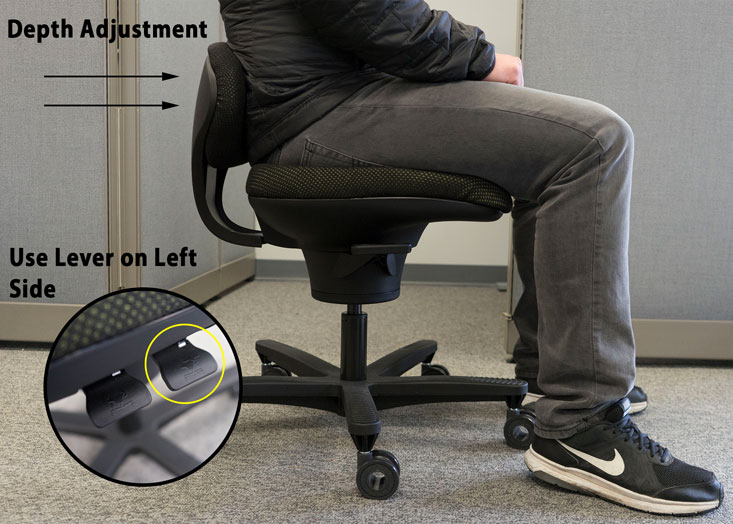
Our team saw this feature as particularly useful given our body size ranges. Smaller users will need the ‘pelvic stabilizer’ all the way forward while larger users will need it all the way back. Its adjustability allowed each person on our team to find a comfortable, stabilizing position to work from. The adjustment may make a slight spring noise, but it’s a small price to pay for a happy lower back.
Sculpted Ergonomic Seat
Aside from the short back of the CoreChair, perhaps the feature that most immediately catches the eye is the contoured seat cushion. Billed as ‘relieving pressure points’, the cushion is designed to keep the blood flowing through your legs, bottom, torso, and all the way to your brain while you sit—even enhancing your focus and productivity.
While we didn’t notice any extraordinary gains in productivity (very hard to measure), we did get the sensation we were hovering over the ground while sitting on the CoreChair. You’ll notice the dip in the cushion in the center of the seat. With less surface area resting against your body, there’s less pressure against it that would slow blood flow and cause discomfort, such as your legs falling asleep.
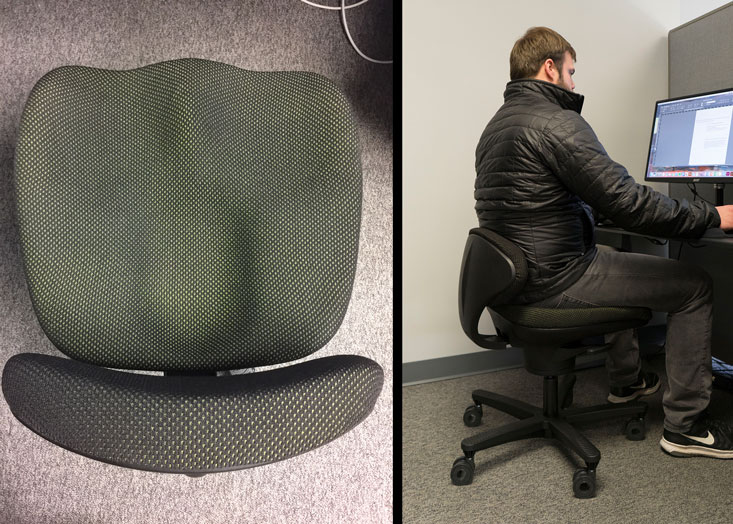
Over the course of the several weeks we used the CoreChair, not once did a member of our team complain of pain due to pressure applied from the seat cushion on the body. The cushion itself is generously soft, so you sink in at least an inch or two, and the cut-out section for your legs achieves a similar purpose to the dip in the middle—relieving pressure on your legs while you sit.
No Arms? No Problems.
Chair arms cause more problems than they solve. When your chair has arms, they are inviting you to lean on them—bending over, slouching, and generally adopting a poor posture. Without the arms, you must rely on your core to stabilize you. And the additional absence of a steady seat means you must rely doubly on your core.
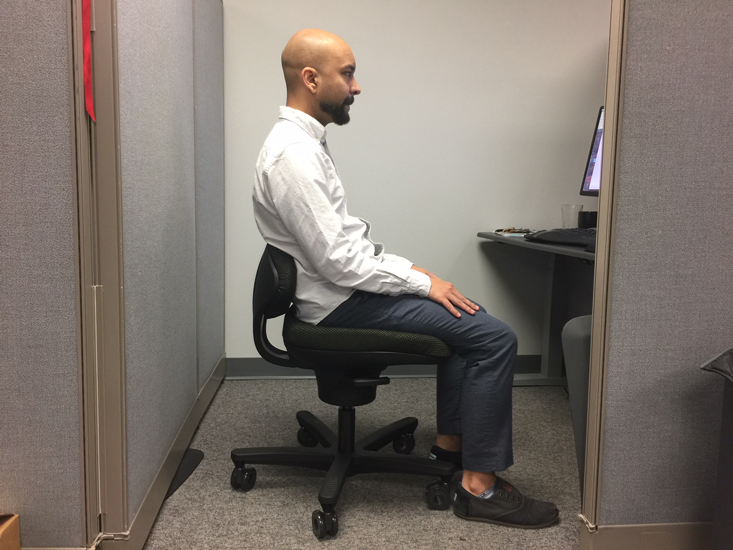
It can be tempting to lean on your desktop since you don’t have chair arms available. But this defeats the purpose of having a CoreChair. We recommend changing the tension level to the highest possible, and staying disciplined to sit upright. No pain, no gain.
Choosing Your CoreChair
There are six different variations of the CoreChair available. Of those, we tested the Tall Version (for those above 5’6”), with a Knit Seat Cushion in Black on Green. There’s also a Short Version available (for those under 5’6”), and a Sport Seat Cushion (faux leather) that comes in Black, Blue, or Gray.
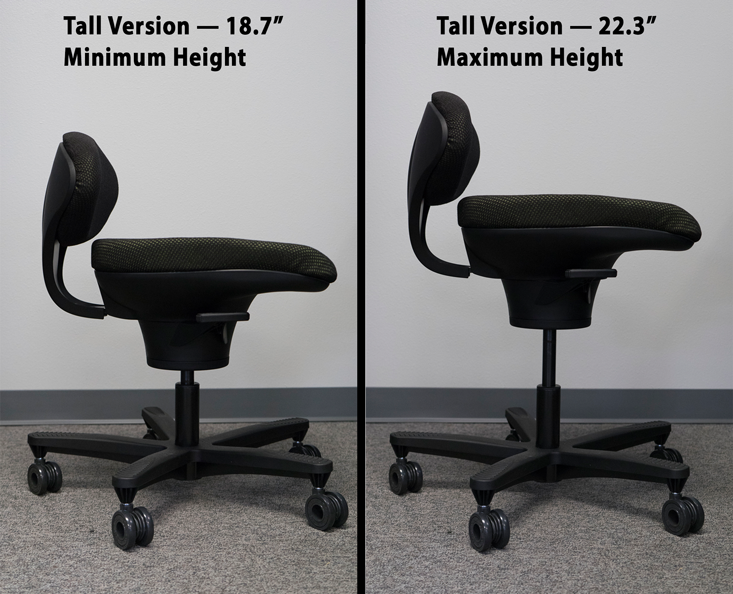
Our testers were both under and over 5’6” (5’3”, 5’6, 5’10), and we think it’s important to buy the properly-sized chair. If you are a shorter person and have the taller chair, you’ll tend to tilt forward in your seat, leaning toward your desk and putting pressure on your feet and knees to keep yourself stabilized—obviously poor posture. But if you’re shorter and have the proper shorter chair, you can keep your feet flat on the ground and enjoy the CoreChair’s motion in a healthy, non-straining way. There’s no up-charge for the taller chair.
The Bottom Line
The mounting pile of scientific research attesting to the health benefits of the CoreChair is impressive. Studies have been done at the University of Waterloo and Cornell (among other universities) suggesting enhanced blood flow, lowered pressure points, and even better cognitive functioning—and the list of accredited institutions testing the CoreChair is only growing.
What’s our verdict? In the growing field of ‘active sitting’ products, the CoreChair stands out as an innovative, well-designed, and scientifically-validated solution to get more movement while sitting. It may not win out against the BackApp 2.0 in terms of style (the BackApp 2.0’s flashy Alcantara seat cushions still catch our eye), but if you want a chair that will strengthen your core muscles over time, and do so while increasing blood flow through your legs (and perhaps even boosting your mental performance), it’s worth taking a closer look at the CoreChair. We’ll be keeping ours.
If you’d like to learn about all the newest and coolest active ergonomic chairs, check out our comprehensive comparison review.
To keep in the loop about everything that’s new in office fitness, sign up for our WorkWhileWalking newsletter (fill up form below).
Color Options
Knit Cushion: Black on Green
Sport Cushion (Faux Leather): Black, Blue, or Gray
Dimensions
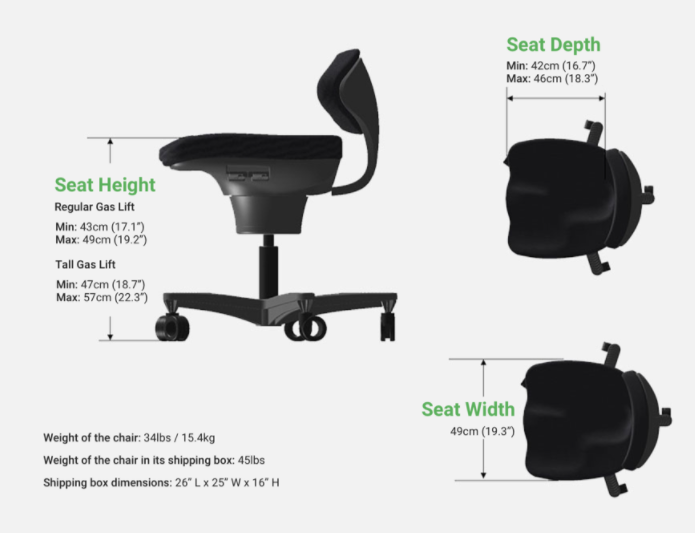
Warranty
12 YEAR WARRANTY
Shipping
5-7 Business Days

2 Comments
Leave a response >